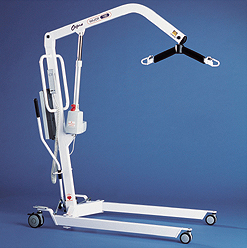Hoists
What is a hoist?
A hoist is a device that can consist either of a static or a mobile frame. This frame is composed by a lifting mechanism powered by battery, which reduces the need of lifting a person manually.
It can be used to lift people, help them to stand and move, and transfer them in and out of bed, bath, or chair. Currently, there are two main types available on the market, the mobile and the overhead hoist. They are designed to meet different needs and fit into specific space outlines.
Mobile Hoist
The mobile hoist is the most common type. It is designed for everyday use and is lightweight. As such, this means it is easy to manoeuvre and unlike overhead hoists, it doesn’t require a track or rail.
Consequently, they can be used in different situations and potentially in every room of the house. They are even ideal to lift a person in and out of a vehicle.
This type of hoist can offer multiple types of positioning, enabling the user to be put into the optimal position.
As mobile hoists are battery-powered, the carer should always check the battery indicator and/or recharge the batteries to prevent failures in the system.
The advantages of a Mobile Hoist in a nutshell:
- Can be moved from room to room
- Safe for the carer and patient
- Can be used for lifting patients from/to chair, bath, bed, armchair, shower chair, etc
- Safe working load of 160-250 kg
- Transportable: for example, if you go on holiday, you can take it with you.
- No installation required
The Disadvantages of a Mobile Hoist
- Storage space is required
- If people forget to charge it, the battery loses charge
- It takes floor space
- In most cases, it requires two carers to be utilised
- In some house environments, it can be difficult to be relocated because of narrow doorways, tight turns or small rooms
It is always advisable to seek independent advice before buying any hoists or manual handling equipment to ensure you make an informed and sensible choice. It is strongly advised that you contact your local social services and seek advice from a professional such as an Occupational Therapist, as they should be able to undertake a full assessment, and provide and maintain the appropriate equipment, as well as providing the carer with all the training required.
One common complaint raised against hoists is that they take too long to use. Carers often say they instead prefer just to lift the person themselves. This can often be because the person using the hoist is unfamiliar with the equipment or because it is unsuitable for the task. This can normally be easily addressed by the provision of the right equipment and thorough training and support in its use. Ultimately the aim of using any manual handling equipment should be to reduce the risk of an injury to the lowest level possible.
Things to take into account when using a hoist
- make sure there is sufficient space under the bed for the chassis and wheels of the hoist.
- if raisers are recommended to raise the bed for hoist access, ensure (if the increased height would make existing transfers more difficult) that they are only fitted when the hoist is available for use.
- is there room to move the hoist away from the bed with the person sitting in the sling? It is preferable to leave enough space to pull the hoist straight back and wheel a wheelchair or commode in under the person to avoid the carers having to turn the hoist and risk twisting their backs.
- will the furniture need rearranging to make sufficient space to manoeuvre the hoist?
- can the hoist be pushed easily over the floor covering? Thick pile carpet and thresholds can be difficult.
- if the height of the bed has been raised (e.g. by adding an extra mattress for pressure relief) can the hoist still lift the person so that his/her bottom clears the mattress surface?
- if the person falls, will the hoist reach down far enough to lift him/her from the floor?
- where will the hoist be stored when not in use?

